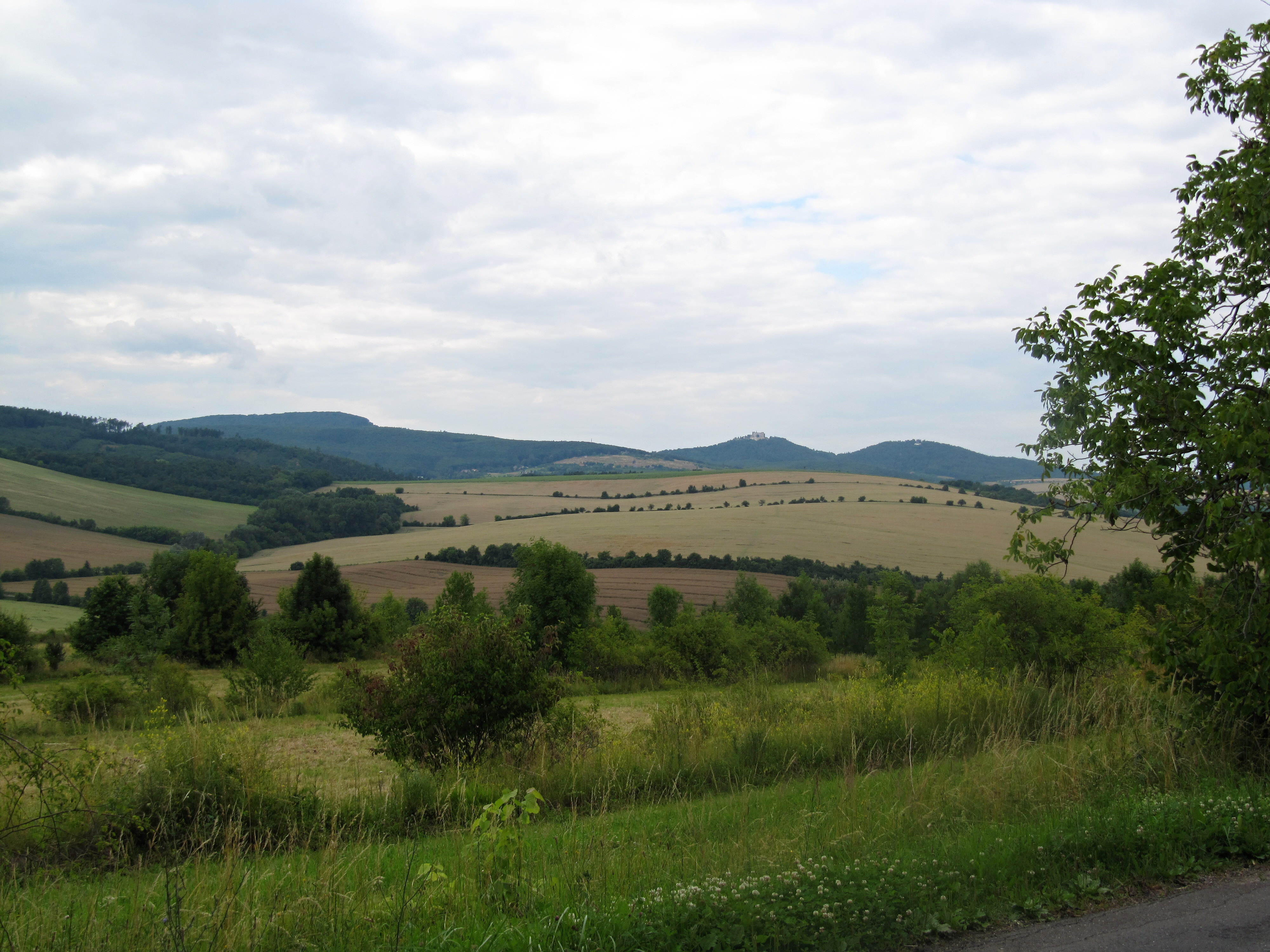|
Modrá (Uherské Hradiště District)
Modrá (formerly Nová Ves; german: Neudorf) is a municipality and village in Uherské Hradiště District in the Zlín Region of the Czech Republic. It has about 700 inhabitants. Geography Modrá lies approximately northwest of Uherské Hradiště and south-west of Zlín. It is located in the Chřiby highlands. History The territory of today's municipality has been inhabited since time immemorial. Archaeological finds testify to the human presence in about 5,000 BC. The present village was part of Velehrad until 1786, when it became separate. Sights In Modrá is an archaeological site with excavations from the Great Moravian period. The findings are presented in Modrá Archeoskanzen, which is an archaeological open-air museum with replicas of the Great Moravia period buildings. Živá voda Modrá is an outdoor exposition of Moravian wetlands biotop, containing indoor section with underwater glass tunnel showing freshwater fish in the outdoor pond. The outside exposition ha ... [...More Info...] [...Related Items...] OR: [Wikipedia] [Google] [Baidu] |
Obec
Obec (plural: ''obce'') is the Czech language, Czech and Slovak language, Slovak word for a municipality (in the Czech Republic, in Slovakia and abroad). The literal meaning of the word is "Intentional community, commune" or "community". It is the smallest administrative unit that is governed by elected representatives. Cities and towns are also municipalities. Definition Legal definition (according to the Czech code of law with similar definition in the Slovak code of law) is: ''"The municipality is a basic territorial self-governing community of citizens; it forms a territorial unit, which is defined by the boundary of the municipality."'' Every municipality is composed of one or more cadastre, cadastral areas. Every municipality is composed of one or more administrative parts, usually called town parts or villages. A municipality can have its own flag and coat of arms. Czech Republic Almost whole area of the republic is divided into municipalities, with the only exception be ... [...More Info...] [...Related Items...] OR: [Wikipedia] [Google] [Baidu] |
Velehrad
Velehrad is a municipality and village in Uherské Hradiště District in the Zlín Region of the Czech Republic. It has about 1,100 inhabitants. It is known as a pilgrimage site. Geography Most of the municipality lies in the Chřiby highlands. The built-up area lies in the valley of the stream Salaška. History The first written mention of Velingrad is from 1141. It was however the old name of neighbouring Staré Město, from which the name Velehrad was derived. In 1205, Margrave of Moravia Vladislaus III founded here a Cistercian monastery. The Romanesque monastery complex was finished in the first half of the 13th century. After the monastery was abolished in 1784 by a decree of Emperor Joseph II, the people who worked in the monastery founded a municipality. The dilapidated monastery complex was gradually repaired in the mid-19th century. Since 1890 it has been managed by Society of Jesus. It became an important pilgrimage site with the annual participation of tens of tho ... [...More Info...] [...Related Items...] OR: [Wikipedia] [Google] [Baidu] |
Modra Nad Cirochou
Modra nad Cirochou is a village and municipality in Humenné District in the Prešov Region of north-east Slovakia. History In historical records the village was first mentioned in 1451. Geography The municipality lies at an altitude of 210 metres and covers an area of 7.345 km². It has a population Population typically refers to the number of people in a single area, whether it be a city or town, region, country, continent, or the world. Governments typically quantify the size of the resident population within their jurisdiction using a ... of about 1030 people. References External links * * http://www.statistics.sk/mosmis/eng/run.html Villages and municipalities in Humenné District {{Prešov-geo-stub ... [...More Info...] [...Related Items...] OR: [Wikipedia] [Google] [Baidu] |
Bojná
Bojná ( hu, Nyitrabajna) is a municipality in the Topoľčany District of the Nitra Region, Slovakia. The village has a population of 2013 people. The main landmark is Catholic Church of All Saints built in 1787. Opposite the church stands (since World War II defunct) synagogue, later turned community center then car repair and nowadays a bar. The village stretches about 4 km along river Bojnianka which continues through villages of Veľké Dvorany, Urmince and Chrabrany before emptying into the Nitra river, itself a tributary of the Danube. Etymology The name is derived from ''boj'' (fight, battle) preserved in all Slavic languages. ''Bojna'' or ''Bojnica'' meant ''place of battle'', ''battleground'' (modern Slovak: ''bojisko'') but the name could be derived also from some personal name related to ''boj'', e.g. ''Bojan'', ''Bojen''. In this case, Bojná is shortening of ''Bojnja Ves'' - ''village of Bojen''. Similar names in Slovakia are Bojnice, Bojničky, Bojanová, Boja ... [...More Info...] [...Related Items...] OR: [Wikipedia] [Google] [Baidu] |
Sister City
A sister city or a twin town relationship is a form of legal or social agreement between two geographically and politically distinct localities for the purpose of promoting cultural and commercial ties. While there are early examples of international links between municipalities akin to what are known as sister cities or twin towns today dating back to the 9th century, the modern concept was first established and adopted worldwide during World War II. Origins of the modern concept The modern concept of town twinning has its roots in the Second World War. More specifically, it was inspired by the bombing of Coventry on 14 November 1940, known as the Coventry Blitz. First conceived by the then Mayor of Coventry, Alfred Robert Grindlay, culminating in his renowned telegram to the people of Stalingrad (now Volgograd) in 1942, the idea emerged as a way of establishing solidarity links between cities in allied countries that went through similar devastating events. The comradesh ... [...More Info...] [...Related Items...] OR: [Wikipedia] [Google] [Baidu] |
Milovice Nature Reserve
Milovice Nature Reserve ( cs, Přírodní rezervace Milovice) is a nature reserve next to the towns of Milovice and Benátky nad Jizerou in Nymburk District, Central Bohemian Region, Czech Republic. Established in 2015, the area is administered by the Česká krajina o.p.s. organization, as a part of Evropsky významná lokalita Milovice-Mladá CZ0214006 protected area, part of the European Union project Natura 2000. This reserve is a pioneering project of cooperation between several scientific bodies (Czech Academy of Sciences, University of South Bohemia České Budějovice, Charles University Prague, Czech University of Life Sciences Prague, Masaryk University Brno among others) and draws support from many organizations and private sponsors (EU's Operational Programme Environment - , Central Bohemian Region, EKOSPOL, Net4Gas, Pivovar Zubr, Nadační fond rodiny Orlických, JK Jewels, State Environmental Fund of the Czech Republic, Milovice and Benátky nad Jizerou townsh ... [...More Info...] [...Related Items...] OR: [Wikipedia] [Google] [Baidu] |
Aurochs
The aurochs (''Bos primigenius'') ( or ) is an extinct cattle species, considered to be the wild ancestor of modern domestic cattle. With a shoulder height of up to in bulls and in cows, it was one of the largest herbivores in the Holocene; it had massive elongated and broad horns that reached in length. The aurochs was part of the Pleistocene megafauna. It probably evolved in Asia and migrated west and north during warm interglacial periods. The oldest known aurochs fossils found in India and North Africa date to the Middle Pleistocene and in Europe to the Holstein interglacial. As indicated by fossil remains in Northern Europe, it reached Denmark and southern Sweden during the Holocene. The aurochs declined during the late Holocene due to habitat loss and hunting, and became extinct when the last individual died in 1627 in Jaktorów forest in Poland. The aurochs is depicted in Paleolithic cave paintings, Neolithic petroglyphs, Ancient Egyptian reliefs and Bronze ... [...More Info...] [...Related Items...] OR: [Wikipedia] [Google] [Baidu] |
Archaeological Open-air Museum
An archaeological open-air museum is a non-profit permanent institution with outdoor true-to-scale architectural reconstructions primarily based on archaeological sources. It holds collections of intangible heritage resources and provides an interpretation of how people lived and acted in the past; this is accomplished according to sound scientific methods for the purposes of education, study and enjoyment of its visitors. Components The above definition was made by EXARC, a global network of professionals for those active in archaeological open-air museums, experimental archaeology, ancient technology and interpretation, using ICOM's definition of museums. By that time Roeland Paardekooper was their director. Further explanation of its components: *''Museum'' – "A museum is a non-profit, permanent institution in the service of society and its development, open to the public, which acquires, conserves, researches, communicates and exhibits the tangible and intangible her ... [...More Info...] [...Related Items...] OR: [Wikipedia] [Google] [Baidu] |
Great Moravia
Great Moravia ( la, Regnum Marahensium; el, Μεγάλη Μοραβία, ''Meghálī Moravía''; cz, Velká Morava ; sk, Veľká Morava ; pl, Wielkie Morawy), or simply Moravia, was the first major state that was predominantly West Slavs, West Slavic to emerge in the area of Central Europe, possibly including territories which are today part of the Czech Republic, Slovakia, Hungary, Austria, Germany, Poland, Romania, Croatia, Serbia and Ukraine. The only formation preceding it in these territories was Samo's Empire, Samo's tribal union known from between 631 and 658 AD. Its core territory is the region now called Moravia in the eastern part of the Czech Republic alongside the Morava (river), Morava River, which gave its name to the kingdom. The kingdom saw the rise of the first ever Slavic literary culture in the Old Church Slavonic language as well as the expansion of Christianity, first via missionaries from East Francia, and later after the arrival of Saints Cyril and Metho ... [...More Info...] [...Related Items...] OR: [Wikipedia] [Google] [Baidu] |
Archaeological Site
An archaeological site is a place (or group of physical sites) in which evidence of past activity is preserved (either prehistoric or historic or contemporary), and which has been, or may be, investigated using the discipline of archaeology and represents a part of the archaeological record. Sites may range from those with few or no remains visible above ground, to buildings and other structures still in use. Beyond this, the definition and geographical extent of a "site" can vary widely, depending on the period studied and the theoretical approach of the archaeologist. Geographical extent It is almost invariably difficult to delimit a site. It is sometimes taken to indicate a settlement of some sort although the archaeologist must also define the limits of human activity around the settlement. Any episode of deposition such as a hoard or burial can form a site as well. Development-led archaeology undertaken as cultural resources management has the disadvantage (or the ben ... [...More Info...] [...Related Items...] OR: [Wikipedia] [Google] [Baidu] |
Chřiby
Chřiby (german: Marsgebirge, the "Mars Mountains") is a geographic region of the Czech Republic, part of the Central Moravian Carpathians of the Outer Western Carpathians. The area is a nature park and tourist park, offering a variety of natural features, rock formations, and historical monuments. Chřiby is the highest portion of the Central Moravian Carpathiants, composed of clay and sandstone cliffs, covered by dense deciduous forest, crossed by the Morava River, and dotted with Czech national parks and nature reserves. The highest point is Brdo, at . The name Chřiby is of ancient origin. The region was populated by humans as early as the Paleolithic era, and on the medieval trade route from the Adriatic to the Baltic; among the many historical resources of the area is Buchlov Buchlov (german: Buchlau) is a royal castle in Buchlovice in the Zlín Region of the Czech Republic It is located on an eponymous hill with an elevation of within the Chřiby mountain range. Hi ... [...More Info...] [...Related Items...] OR: [Wikipedia] [Google] [Baidu] |
_01.jpg)

.jpg)




